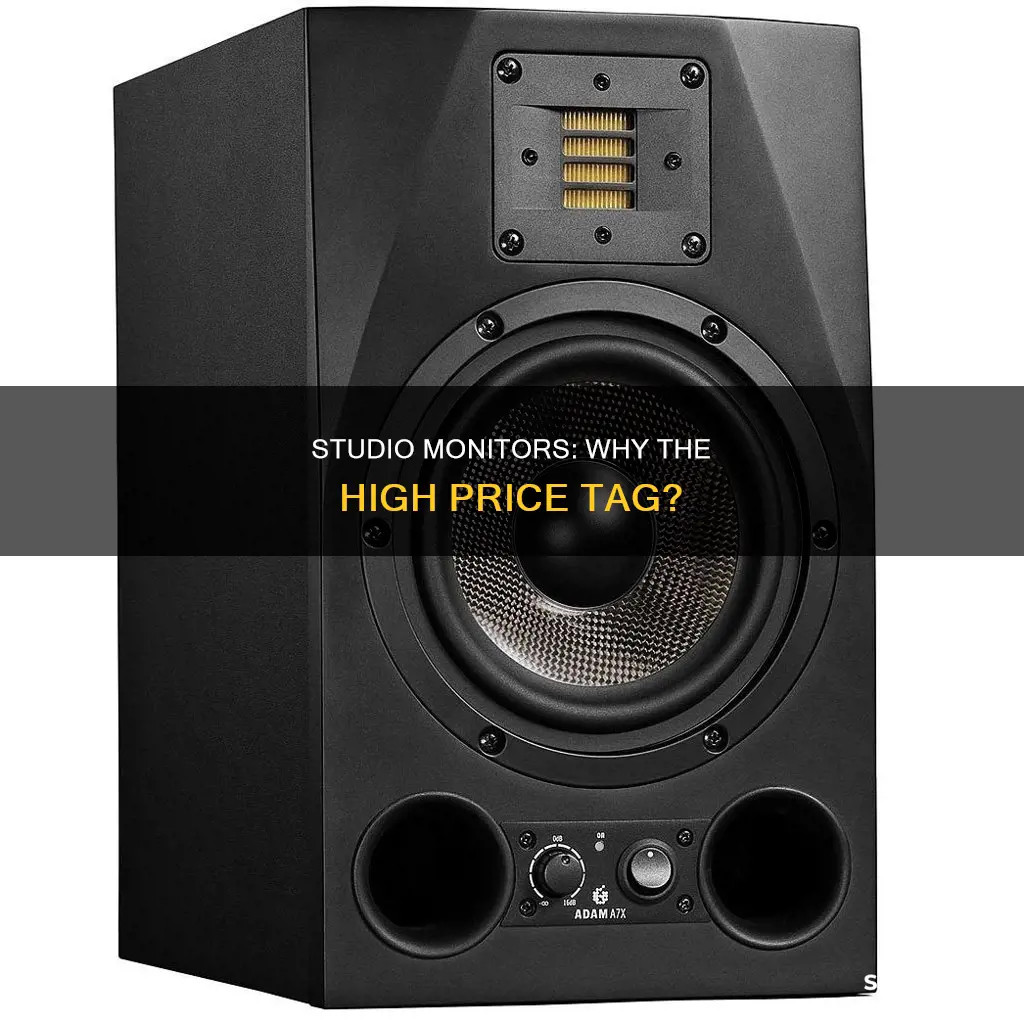
Studio monitors are an essential component of any recording studio, and their quality can significantly impact the final product. While it is possible to purchase studio monitors at various price points, the top-tier options can cost upwards of $100,000. So, what makes these monitors so expensive?
| Characteristics | Values |
|---|---|
| Price | Studio monitors can range from a few hundred dollars to $100,000. |
| Purpose | Studio monitors are used for mixing and mastering audio recordings. |
| Quality | More expensive studio monitors offer improved sound quality, including flatter frequency response, better stereo imaging, and reduced distortion. |
| Science | The high cost of studio monitors is due to the scientific research and engineering that goes into their design and construction. |
| Calibration | High-end studio monitors are meticulously tested and calibrated to ensure accurate sound reproduction. |
| Parts | Expensive studio monitors use higher-quality parts, which contribute to better sound quality and longer product lifespan. |
| Manufacturing | Studio monitors are often handcrafted by skilled engineers, contributing to their high cost. |
| Target Audience | Studio monitor manufacturers cater to specialist professionals who demand high-quality equipment, which justifies the higher prices. |
| Competition | The audio equipment market is highly competitive, with manufacturers investing in research and development to create technologically advanced products. |
| Bundling | Studio monitors are often sold individually to keep prices competitive and avoid hidden additional costs for buyers. |
| Power | Studio monitors require individual power supplies, which can impact the design and pricing of the product. |
What You'll Learn

Studio monitors are designed and calibrated to give an accurate sound
The process of creating such precise and reliable studio monitors involves significant labour, expertise, and cost. Engineers and scientists invest countless hours into testing and calibrating these monitors to ensure they deliver an accurate sound. This level of craftsmanship and precision naturally comes at a higher price point, reflecting the extensive work that goes into creating these specialised pieces of equipment.
The design of studio monitors prioritises accuracy and transparency in audio reproduction. They aim to minimise any colouration or distortion that could interfere with the original sound. This means that the monitors themselves should not impart any significant sonic signature or alteration to the source material. Instead, they strive for neutrality and precision, allowing engineers and producers to make informed decisions about their mixes.
The quality of studio monitors can vary, and it's important to understand that price doesn't always equate to performance. While more expensive monitors often offer superior components, better build quality, and more advanced features, it's not solely about the price tag. Some lower-priced options can still provide excellent sound quality and be suitable for certain applications.
The room acoustics also play a crucial role in the accuracy of studio monitors. The interaction between the monitors and the room can either enhance or degrade the sound. Proper acoustic treatment, such as bass traps, absorber panels, and diffusion elements, is essential to ensure that the monitors perform optimally in the given space.
In summary, studio monitors are meticulously designed and calibrated to deliver an accurate and reliable sound. This attention to detail and pursuit of sonic integrity come at a cost, reflecting the extensive labour, expertise, and specialised components involved in their creation. While price can be an indicator of quality, it's not the sole determining factor, and a combination of monitor quality and room acoustics contributes to the overall accuracy of the sound.
Smart TV or Monitor: Which Should You Buy?
You may want to see also

They are built with high-quality parts and attention to detail
Studio monitors are often expensive because they are built with high-quality parts and attention to detail. When you purchase a pair of studio monitors, you can be confident that they will sound exactly as they should because they have been meticulously tested and calibrated.
The best engineers and machinery are involved in the production process, ensuring that these monitors are of the highest quality. This level of craftsmanship and precision results in a product that is reliable and consistent. Every aspect of the monitor, from the drivers to the enclosure, is designed to deliver accurate and detailed sound.
In addition, studio monitors are constructed with high-performance drivers and tweeters. The design of these components is meticulously crafted to produce a wide range of frequencies with exceptional clarity and precision. This level of engineering ensures that the monitors can handle high volumes without distortion, providing a clear and accurate representation of the original sound.
Furthermore, the enclosures of studio monitors are carefully constructed to enhance sound quality. The enclosures are designed to minimise resonance and ensure smooth power delivery. This attention to detail in the construction of the enclosure results in a more accurate and detailed sound reproduction.
The investment in high-quality parts and expert craftsmanship ensures that studio monitors deliver exceptional performance and durability. The precision engineering and attention to detail result in a product that is reliable, consistent, and capable of producing accurate and detailed sound for many years.
While the cost of studio monitors may be high, the investment is justified by the superior performance and longevity of these precision audio tools.
Studio Monitor-Mixer Setup: A Comprehensive Guide
You may want to see also

They are made by the best engineers and machinery
Studio monitors are so expensive because they are made by the best engineers and machinery. When you invest in a pair of studio monitors, you're paying for the expertise and craftsmanship of highly skilled professionals who have dedicated their careers to perfecting the art of speaker design and manufacturing.
These engineers have a deep understanding of acoustics, electrical engineering, and materials science, which they leverage to create studio monitors that reproduce sound with exceptional accuracy and clarity. They carefully select and assemble each component, ensuring optimal performance and longevity.
The manufacturing process itself is also a testament to precision and quality. The best machinery is utilised to fabricate and assemble the intricate parts of studio monitors. From advanced CNC machines that shape speaker cabinets with meticulous accuracy to state-of-the-art testing and calibration equipment that ensures each driver and electronic component performs flawlessly, the manufacturing process is a testament to technical excellence.
In addition to the engineering prowess and technological advancements, the time and labour invested in crafting these studio monitors contribute to their cost. Each unit undergoes rigorous testing and calibration to ensure it meets the exacting standards of the industry. This meticulous attention to detail and commitment to quality drive up the price but result in a product that is reliable, consistent, and trusted by audio professionals worldwide.
Furthermore, the use of premium materials and components cannot be understated. Studio monitors demand high-quality drivers, magnets, crossover networks, and electronic components to deliver accurate sound reproduction. These specialised parts are meticulously sourced or designed specifically for their role in creating an exceptional listening experience. The research and development required to innovate and enhance these components also contribute to the overall cost.
In summary, the high price tag of studio monitors is a reflection of the expertise, craftsmanship, technology, and materials that go into their creation. The best engineers and machinery in the industry come together to produce these precision tools for audio professionals, ensuring that every nuance of a musical performance is accurately captured and reproduced.
Simple Ways to Check If Your Monitor Runs in HD
You may want to see also

They are tested rigorously
Studio monitors are tested and calibrated to ensure they deliver the best sound quality. This process involves rigorous testing and fine-tuning to achieve a flat frequency response, which is crucial for accurate audio reproduction. The goal is to minimise any colouration or distortion that could affect the accuracy of the sound.
The testing phase is crucial in identifying and addressing any issues with the studio monitors. This process involves measuring the frequency response of the monitors and making adjustments to ensure they meet the required standards. In addition, other aspects such as transient reproduction and stereo imaging are also evaluated and optimised. This attention to detail ensures that the monitors provide an accurate representation of the audio across all frequencies and improves the overall listening experience.
Calibration is another critical aspect of the process. It involves fine-tuning the studio monitors to ensure they produce sound consistently and accurately. This calibration takes into account the unique characteristics of each monitor, ensuring optimal performance. The process involves adjusting the gain, EQ, and other settings to bring the monitors within specified tolerances. By doing so, manufacturers can guarantee that their products will deliver consistent and reliable performance.
In addition to testing and calibration, studio monitors are also put through their paces in real-world scenarios. This includes evaluating their performance in different acoustic environments and with various types of audio content. This real-world testing ensures that the monitors can handle a variety of musical genres and acoustic conditions, providing consistent results regardless of the listening environment.
The rigorous testing and calibration processes are essential in ensuring the high quality and performance of studio monitors. By investing in these procedures, manufacturers can guarantee that their products will meet the exacting standards required in professional audio applications. As a result, studio monitors command a higher price point, reflecting the extensive labour, engineering expertise, and attention to detail that goes into their design and production.
Calibrating Studio Monitors: Using Pink Noise for Optimal Results
You may want to see also

They are an important part of the recording process
Studio monitors are an indispensable part of the recording process. They are what you test your mix on, and you want speakers that will give you an accurate sound with everything you designed and mixed in readily there and accessible to the ear.
If you're mixing on cheap headphones, not only will you miss hearing all the frequencies, but they're also not as well-calibrated as proper studio monitors. This means you have an incomplete picture of how your work actually sounds. Studio monitors are designed to give you a more accurate representation of your mix.
Studio monitors are also important because they are one of the few pieces of equipment that directly impact the quality of your recordings. While other equipment in the studio might make the recording process easier, studio monitors are one of the only pieces of equipment that can improve the quality of the final product.
Additionally, studio monitors can help you create a mix that translates well across different speaker systems. A good pair of studio monitors will allow you to hear how your mix will sound on different types of speakers, from high-end home theatre systems to cheap earbuds. This is crucial because most people will not be listening to your music on studio-quality speakers.
Finally, studio monitors are built to last. They are made with high-quality components and designed to withstand the rigours of daily use in a recording studio. This means you can rely on them to provide accurate sound reproduction for years to come.
Asus Monitor Models: Identifying Your Display
You may want to see also
Frequently asked questions
Studio monitors are expensive because they are one of the most important elements of a recording studio. They are what you test your mix on, so you want speakers that are going to give you an accurate sound.
When mixing on cheap headphones, you’re not going to hear all the frequencies that are there. They’re also nowhere near as well-calibrated as proper studio monitors will be, meaning you have an incomplete picture of how your work actually sounds.
The M-Audio BX4 is compact and affordable with excellent low-frequency response. They are available at $200 to $400 and are probably the cheapest you will want to go. The KRK Rokit 7 G4 nearfield monitor speakers are EDM-ready, offer extremely good bass sounds and amazing EQ for their price point. They’re in the $700 to $900 range.
The Focal Shape 65 is the best nearfield monitor speaker type at a mid-price range. They can be easily tweaked to your room. Find them at between $1,000 and $1,200. The Genelec 8010A monitors are a compact mid-range 2-way design monitor set with accurate frequency response inside a rugged aluminium enclosure. To buy two, you are looking at roughly $5,000 to $6,000 in total cost.
You don't need studio monitors worth thousands of dollars to make great art. In fact, for many modern musicians and producers, a set of $4,000 studio monitors or less will do just as well, especially among beginner producers or inexperienced ears.







